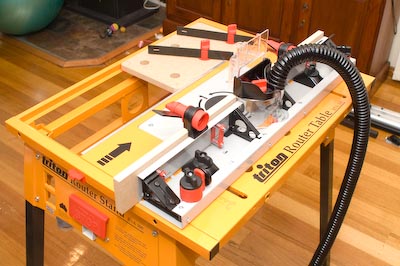The router bit for December is the Carb-i-tool Stacked Rail & Stile Bit (which will be featured in a Video Episode very shortly).

This router bit is unusual from the standard method of cutting rails and stiles, as normally that is performed with two separate bits. In this case, common elements are used for both cutters (which does decrease cost), and makes the transition between the two tasks incredibly easy. This router bit is designed solely for use in a router table, and works much better when the workpiece is being supported by the router table fence.

This is a typical rail and stile joint (and was produced with this cutter). As you can see, the Roman Ogee pattern continues around the interior of the frame, including right into the corner (shown). Anyone attempting to do this simply by first gluing up the frame, then running a bearinged bit around would have discovered that it isn’t possible to get into the corner like this. Secondly, the joint itself would have been a simple butt joint, and therefore would likely require reinforcing (such as a biscuit, spline, pockethole, dowel, domino etc).
Also, notice the slot that has been cut – this is to fit either a raised panel (which will be subject of the next router bit review), or a flat panel (such as plywood, glass, perspex etc).
So what makes a rail and stile different? The secret is how it is assembled. The stiles (the vertical members) are cut, with the pattern (such as the Roman Ogee) running their full length, with no attempt to stop the bit breaking out either end. The rails are cut the same way, but then their ends are given a second treatment, where the reverse of the pattern is cut into them so they fit precisely into the stiles.

In this image, we can see the end of the stile (on the left), and the rail with the reverse pattern cut so it matches in exactly into the stile. This also gives a significant increase in the amount of glue-area, making for a strong joint (well certainly a lot stronger than a simple butt joint!)

This is step one – the primary pattern is cut the length of all the rails and the stiles. The workpiece is placed face-down on the table for this cutter, and the depth of cut is controlled by the bearing.

Next, the rails are turned up the other way, and presented to the upper portion of the cutter, so that the channel cut in step one matches precisely with the bearing (and fits in between the two cutters). Only the end-grain is cut in this step. To line the piece up with the upper portion of the cutter, you can either drop the cutter further down into the table, or (funnily enough) raise the workpiece up to the required height. I decided that this was the better way to go, as it means that I don’t have to play around realigning the cutter every time that I want to make another (door, cupboard side etc). So I came up with this jig:

Ok, it does look a bit weird (like a child’s aeroplane), but there is good reason.
The baseplate has been thicknessed very carefully to raise the workpiece up just the right amount so the top cutters will cut the rails’ end grain perfectly. The thickness of this baseplate has to be matched to the thickness of the stock, so in this case I can only use this jig for 19mm stock. On top of that are two lengths that the rail passes between. They need to be exactly 90 degrees to the ‘wing’ which means the rail is also held exactly perpendicular to the fence. Their ends are sacrificial, and provide tear-out support to the rail as it is being cut. The ‘wing’ runs along the fence, and is high enough to pass completely over the top of the cutter without touching. It is quite long so as to provide plenty of support before and after the router bit so there is little chance the jig can twist during use.

Here you can see the jig in position, ready for the rail to be inserted into the slot, then the whole unit can be run past the router bit.

Finally, here is the resulting cut – you can see the end of the rail that has just had its end-grain machined. The jig certainly makes the task very easy, and very repeatable. You would not dream of trying to cut the end-grain without the workpiece having some form of support (such as a mitre gauge)…..unless you like having workpieces thrown around the workshop, and possibly pulling your hand into the cutter……
So my verdict: I am a big fan of Carb-i-tool bits, and this one is no exception. I am sold on the whole idea of stacked rail and stile bits – I have a couple of sets of the matched pair type, so an quite familiar with setting them up, changing bits during the job to make the rail ends, needing to make another and having to set the first up again etc etc, and having it all in one bit definitely works. The jig works as well as I could have hoped too btw. So if you are wanting to do some rail and stile work, this is definitely a bit worth looking at. There are different profiles of course, simple roundover, Roman Ogee, Classic etc
As I mentioned, there is a video coming very shortly on the topic, and the matching panel will be the subject of next month’s router bit of-the-month.
Filed under: Uncategorized | Tagged: Carb-i-tool, Moulding, Rail and Stile, Raised Panel, Router Bit, Router Table | 2 Comments »

























